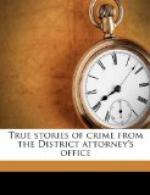O’ROURKE
BROWNE,
to attesting
witness.
WILLIAM P. COLLITON
WILLIAM P. COLLITON to BROWNE, JOHN GARRETSON attesting witness.
JOHN GARRETSON to BROWNE, HERMAN BOLTE attesting witness.
HERMAN BOLTE to BROWNE, BENJ. FREEMAN attesting witness.
BENJ. FREEMAN to BROWNE, WILLIAM R. HUBERT attesting witness.
The Assistant District Attorney rubbed his forehead and wondered who in thunder all these people were. Who, for example, to begin at the beginning, was Charles A. Clark, and why should he be deeding away Ebbe Petersen’s property? And who were Keilly and O’Rourke, and all the rest—Colliton, Garretson, Bolte and Freeman? And who, for that matter, was Hubert?
A score of detectives were sent out to hunt up these elusive persons, but, although the directories of twenty years were searched, no Charles A. Clark, John J. Keilly or I. F. X. O’Rourke could be discovered. Nor could any one named Colliton, Freeman or Hubert be found. The only persons who did appear to exist were Garretson and Bolte.
Quite by chance the Assistant District Attorney located the former of these, who proved to be one of Browne’s clients, and who stated that he had taken title to the property at the lawyer’s request and as a favor to him, did not remember from whom he had received it, had paid nothing for it, received nothing for it, and had finally deeded it to Herman Bolte at the direction of Browne. Herman Bolte, an ex-judge of the Municipal Court, who had been removed for misconduct in office, admitted grumblingly that, while at, one time he had considered purchasing the property in question, he had never actually done so, that the deed from Garretson to himself had been recorded without his knowledge or his authority, that he had paid nothing for the property and had received nothing for it, and had, at the instruction of Browne, conveyed it to Benjamin Freeman. Garretson apparently had never seen Bolte, and Bolte had never seen Freeman, while William R. Hubert, the person to whom the record showed Freeman had transferred the property, remained an invisible figure, impossible to reduce to tangibility.
Just what Browne had attempted to do—had done—was obvious. In some way, being a real-estate lawyer, he had stumbled upon the fact that this valuable tract of land lay unclaimed. Accordingly, he had set about the easiest way to reduce it to possession. To make assurance doubly sure he had forged two chains of title, one through an assumed heir and the other through the owner herself. Then he had juggled the title through a dozen or so grantees, and stood ready to dispose of the property to the highest bidder.
There he stayed in the Tombs, demanding a trial and protesting his innocence, and asserting that if the District Attorney would only look long enough he would find William R. Hubert. But an interesting question of law had cropped up to delay matters.




